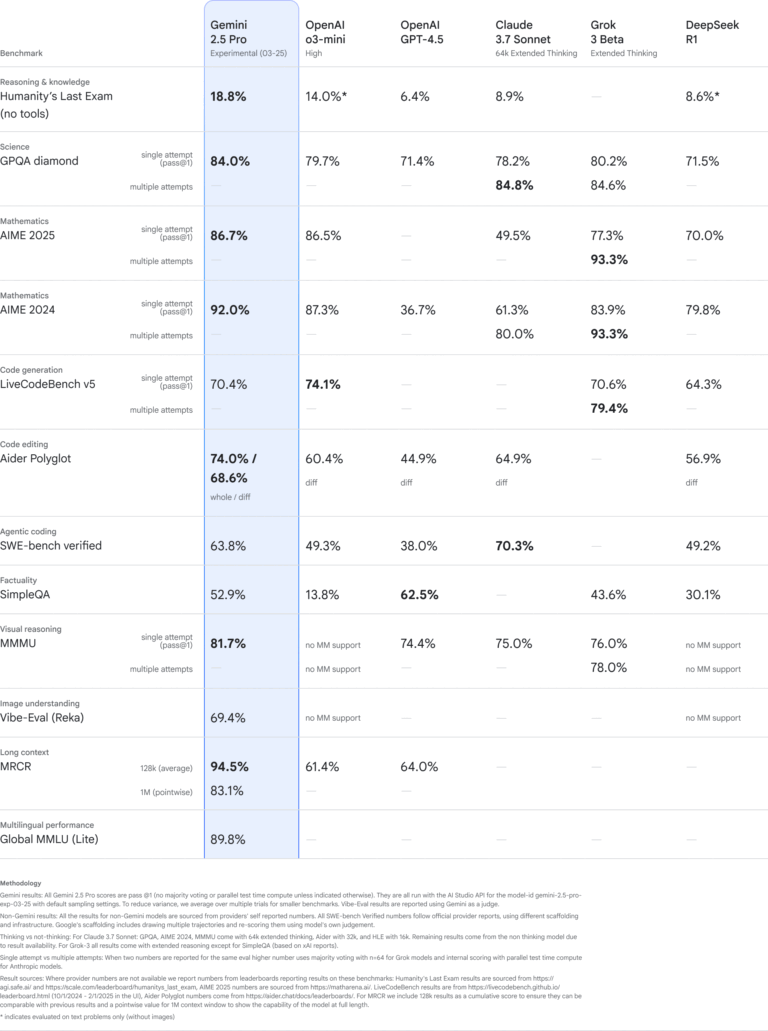Google’s Latest AI Breakthrough Challenges Industry Leaders
The artificial intelligence landscape witnessed a significant shift when Google released Gemini 2.5 Pro, positioning it as a direct competitor to established models like GPT-4.5 and Claude 3.7 Sonnet. This comprehensive evaluation examines how Google’s flagship model performs across critical testing domains, revealing surprising advantages in reasoning capabilities and multimodal processing.
Unlike previous iterations, Gemini 2.5 Pro introduces integrated reasoning architecture that enables step-by-step problem solving, fundamentally changing how the model approaches complex tasks. This built-in “thinking” mechanism sets it apart from competitors that rely on external reasoning tools.
Revolutionary Features That Distinguish Gemini 2.5 Pro
Advanced Context Processing Capabilities
Gemini 2.5 Pro operates with an unprecedented 1 million token context window, expandable to 2 million tokens in future updates. This massive capacity allows the model to process entire codebases, lengthy research papers, and comprehensive documentation sets within a single session.
The practical implications become evident when handling large-scale projects. Where competing models struggle with context limitations, Gemini 2.5 Pro maintains coherent understanding across extensive inputs, making it particularly valuable for enterprise applications requiring deep document analysis.
Native Multimodal Integration
The model processes text, images, audio, and video simultaneously without requiring separate preprocessing steps. This native multimodal capability enables comprehensive analysis across data types, supporting tasks from visual debugging to multimedia content creation.
Enhanced Development Workflow Support
Recent improvements in code generation include superior error handling, cleaner syntax output, and reduced unnecessary imports. The model supports JSON formatting and function calling for structured outputs, streamlining development processes significantly compared to earlier versions.
Comprehensive Benchmark Performance Analysis
Reasoning and Knowledge Assessment Results
Gemini 2.5 Pro demonstrated exceptional performance on the challenging “Humanity’s Final Exam,” achieving 18.8% compared to GPT-4.5’s 6.4% and Claude 3.7 Sonnet’s 8.9%. This substantial performance gap indicates superior unaided reasoning capabilities and knowledge recall.
The GPQA Diamond assessment, testing graduate-level physics knowledge, revealed Gemini 2.5 Pro’s 84.0% pass@1 performance, showcasing its effectiveness in complex STEM problem-solving scenarios.
Mathematical and Logical Problem Solving
Mathematical reasoning tests produced impressive results, with Gemini 2.5 Pro scoring 92.0% on AIME 2024 and 86.7% on AIME 2025 benchmarks. These scores demonstrate consistent logical thinking and mathematical problem-solving capabilities across different test iterations.
Programming and Code Generation Performance
LiveCodeBench v5 testing resulted in a 70.4% score, indicating reliable code generation capabilities. More significantly, the Aider Polyglot assessment for multi-language code editing showed 74.0% performance, while SWE-Bench Verified testing achieved 63.8%, surpassing GPT-4.5’s 38.0% and approaching Claude 3.7 Sonnet’s 70.3%.
Long-Context and Multimodal Processing Excellence
The MRCR Benchmark demonstrated exceptional document comprehension capabilities, achieving 94.5% accuracy at 128k context length with potential expansion to the full 1-million-token window. Additionally, MMMU Benchmark testing revealed 81.7% performance in multimodal tasks combining text, images, and diagrams.
Direct Model Comparisons: Strengths and Applications
Gemini 2.5 Pro vs Claude 3.7 Sonnet
Both models represent flagship offerings released in early 2025, designed for complex coding and reasoning challenges. Claude 3.7 Sonnet provides transparent reasoning through “extended thinking” mode, while Gemini 2.5 Pro offers superior context handling and multimodal support.
Coding Performance Differences:
- Gemini 2.5 Pro excels in creative coding and mathematical thinking
- Claude 3.7 Sonnet demonstrates strength in structured software engineering
- Interactive application development favors Gemini 2.5 Pro, often completing complex tasks like 3D model creation in single attempts
Practical Use Case Optimization:
- Gemini 2.5 Pro: Interactive application development, extensive documentation management
- Claude 3.7 Sonnet: Business communications, structured code refactoring
Cost-Performance Analysis Across Leading Models
Google implemented a two-tier pricing structure separating standard usage (up to 200,000 tokens) from extended usage scenarios. This approach provides flexibility for different project requirements while maintaining competitive pricing relative to capabilities offered.
Comparative pricing considerations reveal:
- GPT-4.5: Higher cost but additional features
- Claude 3.7 Sonnet: Balanced price-performance ratio for structured thinking tasks
- Gemini 2.5 Pro: Competitive pricing considering multimodal capabilities and context window size
Real-World Development Applications
Web Interface and UI Development
Gemini 2.5 Pro generates functional web interfaces by replicating UI layouts from images with approximately 80% visual similarity, outperforming comparable models including GPT-4. This capability proves particularly valuable for rapid prototyping and design implementation.
Enterprise-Scale Project Management
The model assesses entire code repositories and suggests architectural improvements based on scalability analysis and system design insights. This comprehensive evaluation capability supports complex, multi-file projects requiring understanding of component dependencies and system architecture.
Developer Experience and Productivity Gains
Qualitative feedback from development teams indicates significant improvements in debugging capabilities and error diagnosis. The model’s integrated reasoning approach contributes to enhanced code quality while reducing time spent on routine development tasks.
Platform Access and Implementation Options
Gemini 2.5 Pro availability spans multiple platforms catering to different user requirements:
Direct Access Channels:
- Gemini App (mobile and web platforms)
- Google AI Studio for experimentation and testing
- Gemini API integration (model identifier: gemini-2.5-pro-preview-03-25)
- Vertex AI (enterprise deployment, coming soon)
Strategic Use Cases and Optimal Applications
Complex Reasoning and Problem Solving
The integrated “thinking” capabilities enable step-by-step task processing, making Gemini 2.5 Pro highly effective for complex reasoning challenges requiring systematic analysis and logical progression.
Large-Scale Document Analysis
With context windows supporting up to 1 million tokens, the model analyzes comprehensive code repositories and extensive documentation sets within single sessions, eliminating the need for document segmentation that limits other models.
Multimodal Content Processing
Native support for simultaneous text, image, audio, and video processing enables sophisticated multimedia analysis tasks, from debugging with visual screenshots to comprehensive content creation workflows.
Performance Limitations and Considerations
Despite impressive capabilities, Gemini 2.5 Pro faces certain constraints. Free tier users encounter rate limiting that may impact productivity for intensive applications. Additionally, while the model excels at most reasoning tasks, extremely deep logical reasoning scenarios may occasionally present challenges requiring careful prompt engineering.
Future Implications for AI Model Competition
Gemini 2.5 Pro’s introduction intensifies competition among leading AI providers, particularly in reasoning-heavy applications and multimodal processing scenarios. The model’s integrated thinking architecture represents a significant advancement in AI reasoning capabilities, potentially influencing future model development approaches across the industry.
The combination of extensive context handling, multimodal processing, and built-in reasoning positions Gemini 2.5 Pro as a versatile solution for enterprise applications requiring sophisticated AI capabilities. As organizations increasingly rely on AI for complex problem-solving and content creation, models like Gemini 2.5 Pro that combine multiple advanced features within single platforms will likely gain significant adoption across various industries.
If you are interested in this topic, we suggest you check our articles:
- AI-Powered Search Evolves with Reddit Answers
- Avoid This When Entering Prompts for AI Search Tools
- Perplexity’s Challenge to Google’s Search Dominance
- Where Search LLMs Crawl Their Data?
- The Impact of AI Overviews on Search and Website Engagement
Sources: Future AGI, Google Blog
Written by Alius Noreika


